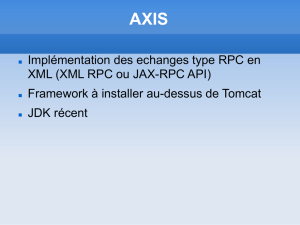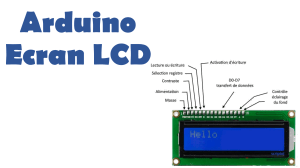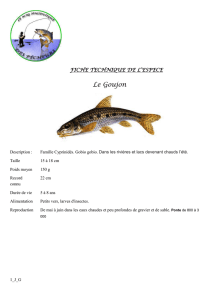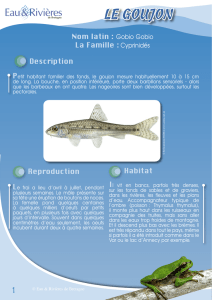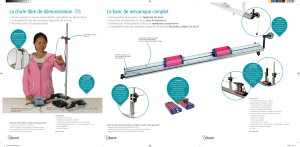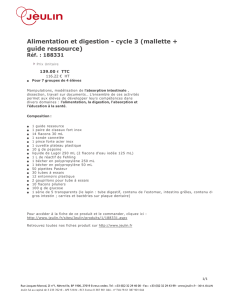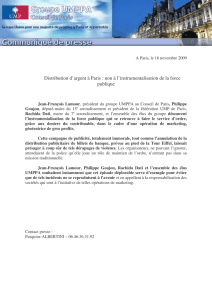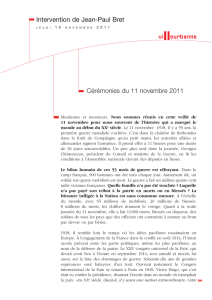Mécanique Mechanics
publicité
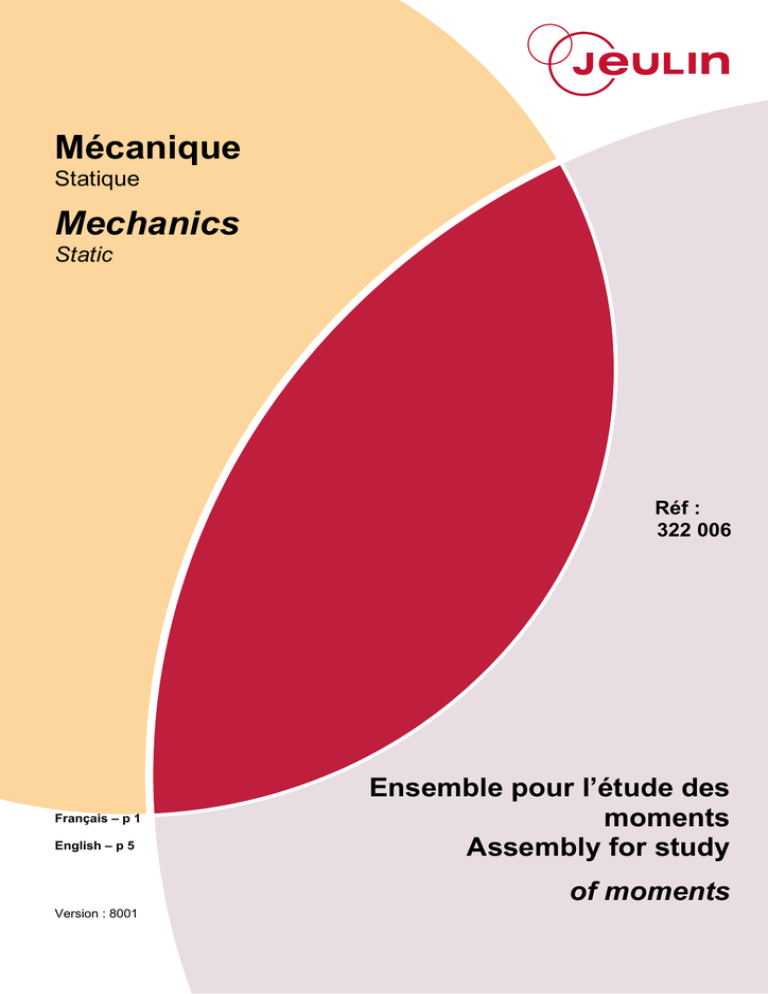
Mécanique Statique Mechanics Static Réf : 322 006 Français – p 1 English – p 5 Ensemble pour l’étude des moments Assembly for study of moments Version : 8001 Mécanique Ensemble pour l’étude des moments Réf : 322 006 1 Principe - description Echelle graduée, fixée à un support aimanté Corps de forme quelconque et perforé à adapter sur la règle 10 goujons (très léger : < 1 g), à planter dans les perforations puis à replier (faire des crochets). Ils sont à relier aux masses par des fils. 4 poulies de diamètre 50 mm montée sur support aimanté Pliage du goujon Le raccourcir si nécessaire Nœud pour accrocher le fils au goujon (« nœud sans nœud ») : la bobine de fils est fournie. Passer le fil de l'empile libre dans l'œillet de l'hameçon. Effectuer au minimum 6 rotations autour de la tige de l'hameçon. L'idéal est de recouvrir toute la tige jusqu'à la courbure de l'hameçon. Serrer 2 Accessoires complémentaires - FRANÇAIS Tableau magnétique. Boîte de masses marquées à crochet. 1 Mécanique Ensemble pour l’étude des moments Réf : 322 006 3 Manipulations 3.1 Moment d’une force par rapport à un axe 3.1.1 Notion de moment La plaque étant en équilibre indifférent, constater, en plaçant un objet très léger (par exemple un goujon seul) dans une de ses perforations, que l'équilibre n'est pas modifié (à cause des frottements inévitables) si le trou est voisin de l'axe de rotation, tandis que la plaque tourne si le trou utilisé est plus excentré. Opérer avec différentes lignes de trous (horizontale, oblique, verticale) pour montrer que l'action d'une force, dans la rotation d'un solide mobile autour d'un axe Δ, dépend de la distance "d" de son support à Δ, et non pas, de la distance axe-point d'application de la force. Vérifier que, quelle que soit l'intensité de la force, celle-ci ne modifie pas l'équilibre de la plaque si sa ligne d'action rencontre l'axe de rotation. Conclusion : Pour une même force appliquée, le corps tourne plus ou moins en fonction de la position du point d’application de cette force par rapport à l’axe de rotation. Æ Le moment de la force est différent. 3.1.2 Expression du moment r Lester la plaque en appliquant une force F A à un goujon quelconque (en A). r Par l'intermédiaire d'un deuxième goujon B, appliquer une force F B différente. Une fois la plaque immobile, repérer sa position d'équilibre par les valeurs : δ = distance entre le goujon A et l’axe de rotation de la plaque. d = distance entre le goujon B et l’axe de rotation de la plaque. r Montrer que si la force F B garde la même intensité et la même direction alors le déplacement du goujon sur l’axe de cette force (en C ou D sur le schéma cidessus) ne modifie pas l'équilibre du corps. On pourra donner d'autres positions, quelconques, au goujon B et modifier l'intensité ou la direction de la force (ou les deux) pour retrouver le même équilibre : constater alors que les produits F x d sont constants et caractérisent l'action d'une force dans l'équilibre de la plaque mobile autour de l'axe. Expression des moments : Moment en A : MA = δ x FA où FA est la force appliquer au point A et δ la distance entre le point d’application de la force et l’axe de rotation du corps. Moment en B : MB = d x FB où FB est la force appliquer au point B et d la distance entre le point d’application de la force et l’axe de rotation du corps. FRANÇAIS 2 Mécanique Ensemble pour l’étude des moments Réf : 322 006 3.2 Théorème des moments 3.2.1 Addition des moments - Conserver les conditions de l’expérience précédente : - Même goujon A, même force FA (même masse). - Même équilibre (même distance δ) que précédemment. - Faire intervenir simultanément deux forces F 1 et F 2 par l'intermédiaire de deux goujons B1 et B2. Mesurer les distances d1 et d2. - En tenant compte de la convention de signe, évaluer les moments : r r M1 = F1 x d1 M2 = F2 x d2 - comparer la somme M1 + M2 à la valeur du produit MB = FB x d de l'expérience précédente. - Réaliser plusieurs combinaisons de forces F 1 et F 2 correspondant au même équilibre de la plaque, les moments M1 et M2 étant de même signe ou de signes contraires. r r 3.2.2 Condition d'équilibre du corps Faire l'inventaire des forces appliquées au corps. Vérifier que : MA = - MB Æ MA + MB = 0 Æ MA + M1 + M2 = 0. Généraliser le résultat précédent et énoncer le théorème des moments : Si un solide mobile autour d’un axe est en équilibre alors la somme des moments des forces qui tendent à le faire tourner dans un sens est égale à la somme des moments des forces qui tendent à le faire tourner dans l’autre sens. 4 Service après vente La garantie est de 2 ans, le matériel doit être retourné dans nos ateliers. Pour toutes réparations, réglages ou pièces détachées, veuillez contacter : JEULIN - SUPPORT TECHNIQUE Rue Jacques Monod BP 1900 27 019 EVREUX CEDEX FRANCE +33 (0)2 32 29 40 50 FRANÇAIS 3 Mécanique Ensemble pour l’étude des moments Réf : 322 006 NOTES FRANÇAIS 4 Mechanics Assembly for study of moments Réf : 322 006 1 Principle - Description Graduated scale, attached to a magnetic support Body of any shape, perforated to adapt to the ruler 10 pins (very light: <1g), to be inserted in the perforations then bent (forming hooks) They should be connected to the weights by string 4 pulleys, diameter 50 mm assembled on a magnetic Bending the pin Shorten necessary if Knot to attach the string to the pin (‘knotless knot’): the reel of string is supplied. Pass the string of the free snell through the eye of the hook. Make a minimum of six rotations around the stem of the hook. The ideal is to cover the entire stem up to the curve of the hook. Tighten 2 Additional accessories - ENGLISH Magnetic table Box of marked weights with a hook 5 Mechanics Assembly for study of moments Réf : 322 006 3 Operations 3.1 Moment of a force in relation to an axis 3.1.1 Concept of a moment With the plate in any state of equilibrium, observe that by placing a very light object (for example, a single pin) in any of its perforations, the equilibrium is not modified (on account of inevitable friction) if the hole is close to the axis of rotation, whereas the plate rotates if the hole used is further from the centre. Use varying lines of holes (horizontal, oblique, vertical) to demonstrate the action of a force, with rotation of a moving solid body around an axis Δ, depends on the distance ‘d’ from its support to Δ, and not the distance between the axis – point of application of the force. Verify that irrespective of the intensity of the force, the latter does not modify equilibrium of the plate if the line of its effect meets the axis of rotation. Conclusion: For a same applied force, the body rotates more or less depending on the position of the point of application of the force in relation to the axis of rotation. Æ The moment of the force is different. 3.1.2 Expression of the moment r Apply ballast to the plate by applying a force F A to any pin (at A). r Using a second pin B, apply a different force F B . Once the plate is immobile, mark the position of equilibrium by the values: δ = distance between pin A and axis of rotation of the plate d = distance between pin B and axis of rotation of the plate. r Demonstrate that if force F B retains the same intensity and the same direction, then movement of the pin around the axis of the force (at C or D on the above diagram) does not modify the equilibrium of the body. Pin B can be placed in any other position and the intensity or direction of the force (or both) modified to restore the same equilibrium: observe that the product of F x d are constant and characterise the action of a force, with equilibrium of the moving plate around the axis. Expression of moments: Moment at A: MA = δ x FA wh where FA is the force applied at point A and δ the distance between the point of application of the force and the axis of rotation of the body. Moment at B: MB = d x FB where FB is the force applied at Point B and D the distance between the point of application of the force and the axis of rotation of the body. ENGLISH 6 Mechanics Assembly for study of moments Réf : 322 006 3.2 Theorem of moments 3.2.1 Addition of moments - Retain the conditions for the previous experiment: - Same pin A, same force FA (same weight). - Same equilibrium (same distance δ) as previously. - Simultaneously apply two forces F 1 and F 2 using two pins B1 et B2. Measure the distances d1 and d2. - Taking into account the signing convention, evaluate the moments: r r M1 = F1 x d1 M2 = F2 x d2 - Compare the sum of M1 + M2 to the value of the product MB = FB x d in the previous experiment. - Make several combinations of forces F 1 and F 2 corresponding to the same equilibrium of the plate, the moments M1 and M2 being of the same sign or opposite signs. r r 3.2.2 Condition for equilibrium of the body Prepare an inventory of the forces applied to the body. Verify that: MA = - MB Æ MA + MB = 0 Æ MA + M1 + M2 = 0. Generalise the previous result and set out the theorem of moments: If a solid body moving around an axis is in equilibrium, then the sum of the moments of forces which make it rotate in one direction is equal to the sum of the moments of forces which make it rotate in the other direction. 4 After-Sales Service This material is under a two year warranty and should be returned to our stores in the event of any defects. For any repairs, adjustments or spare parts, please contact: JEULIN - TECHNICAL SUPPORT Rue Jacques Monod BP 1900 27 019 EVREUX CEDEX FRANCE +33 (0)2 32 29 40 50 ENGLISH 7 Mechanics Assembly for study of moments Réf : 322 006 NOTES ENGLISH 8 Assistance technique en direct Direct connection for technical support Une équipe d’experts à votre disposition du Lundi au Vendredi (8h30 à 17h30) A team of experts at your disposal from Monday to Friday (opening hours) ● Vous recherchez une information technique ? ● You’re looking for technical information ? ● Vous souhaitez un conseil d’utilisation ? ● You wish advice for use ? ● Vous avez besoin d’un diagnostic urgent ? ● You need an urgent diagnosis ? Nous prenons en charge immédiatement votre appel pour vous apporter une réponse adaptée à votre domaine d’expérimentation : Sciences de la Vie et de la Terre, Physique, Chimie, Technologie . We take in charge your request immediatly to Service gratuit * : + 33 (0)2 32 29 40 50 Free service * : + 33 (0)2 32 29 40 50 * Hors coût d’appel * Call cost not included provide you with the right answers regarding your activity field : Biology, Physics, Chemistry, Technology . Aide en ligne : www.jeulin.fr Rubrique FAQ Rue Jacques-Monod, Z.I. n° 1, Netreville, BP 1900, 27019 Evreux cedex, France Tél. : + 33 ( 0 )2 32 29 40 00 Fax : + 33 ( 0 )2 32 29 43 99 Internet : www.jeulin.fr - support@jeulin. fr Phone : + 33 ( 0 )2 32 29 40 49 Fax : + 33 ( 0 )2 32 29 43 05 Internet : www.jeulin.com - [email protected] SA capital 3 233 762 € - Siren R.C.S. B 387 901 044 - Siret 387 901 04400017 couv.indd 4 9/11/05 10:34:25

